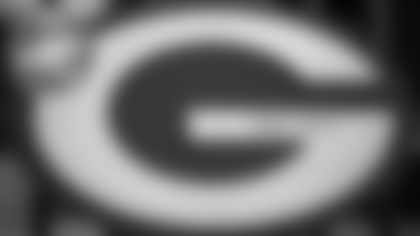Lyle from Waukesha, WI
How is it that the Bears have played 34 more games in the NFL than the Packers? The Packers joined the league one year after the Bears.
There was no set league schedule in the early years. Teams scheduled their own games, and it was basically easier for the Bears to do so because other teams could make more money playing in Chicago than in Green Bay or at home in some cases against an opponent other than Green Bay.
In 1920, the first year of the American Professional Football Association (now the NFL), the Decatur Staleys played 13 games. In 1921, they played 11, while the Packers played six in what was their maiden season in the APFA.
That year, the Packers had difficulty scheduling games and didn't play their first league game until Oct. 23, almost a month after the league opener. At the end of that season, the Staleys – renamed the Chicago Bears in 1922 – scheduled additional games, including their first meeting with the Packers, because they were in a tight race with Buffalo and Akron for the league title and looking to pad their victory total. George Halas didn't agree to play the Packers until five days before the Nov. 27, 1921 game, a story told in greater detail in “The Greatest Story in Sports,” our four-volume history of the Packers.
As a result, the Bears played two games before the Packers played their first league game in 1921 and three games after the Packers played their last league game. Those first two APFA seasons alone accounted for 18 of the 34 extra games.
In 1922 and '23, the Bears played a combined four additional games. In 1924, both teams played 11 games.
In 1925, the Bears played 17; the Packers, 13. That was the year the Bears signed Red Grange out of the University of Illinois in late November and launched a barnstorming trip, where they played eight games in 12 days from Dec. 2-13 with five of them counting in the league standings because they were against league opponents. The Packers played one game in December that season.
There was a four-game disparity again in 1927. The Bears played 14; the Packers, 10. That was the year, the Packers played the Frankford Yellow Jackets on Thanksgiving and then called it quits. They had a game scheduled at Providence on Dec. 11, but didn't have the money to spend 18 days on the road awaiting that game, and they failed to find any other opponents based in the league's Eastern cities willing to play them.
While the Packers headed home, they loaned two of their best players, Verne Lewellen and Jug Earp, to the New York Yankees. Each played three games for the Yankees over the remainder of the season and then returned to the Packers in 1928, per the team's agreement with Yankees owner C.C. Pyle.
In fact, the Yankees had asked the Packers if they could borrow both Lewellen and Curly Lambeau because three of their best backs were dealing with injuries, and they had two games left on their schedule against the eventual champion New York Giants. The Yankees were in their first season in the NFL, and Pyle was looking to beat the Giants and claim superiority in New York. One of the Yankees' injured backs was Grange, who had left the Bears after that barnstorming trip, and was now the Yankees' star and leading gate attraction. While the Packers granted Lewellen permission to play with the Yankees, their executive committee denied Pyle's request for Lambeau because they thought "it unwise for the captain and coach of the Packers to associate himself with any other club in any capacity," according to the Green Bay Press-Gazette at the time.
The Bears also played three more league games than the Packers in 1926 and two more in 1929. The Packers played one more game than the Bears in 1931. The next year, the NFL divided its teams into two divisions and ever since, the Packers and Bears have played the same number of games.
Bill from Menomonee Falls, WI
Not a Packers question per se, but an NFL question. Is it true that the Chicago Bears' first NFL game as the "Bears" was at Horlick Field in Racine, Wis.?
Yes. As stated here previously, the Bears changed their nickname from the Staleys in 1922, and their season opener was played against the Racine Legion at what The Racine Journal-News referred to at the time as "Horlick's Athletic field." It was the Horlick Malted Milk Co. field. The company operated in Racine from 1873 to 1975. The Racine Legion was a member of the NFL from 1922-24, while the Racine Tornadoes were a member in 1926.
The Bears-Legion game drew an estimated 4,000 fans, and the Bears won, 6-0, on two field goals.
Andrew from Greensboro, NC
My dad attended VPI (now VA Tech) from 1938-42, then off to war. He and I in the '60s and now my daughter too, because Carroll Dale was a VPI alum, became Packer fans. Of course, I am biased, but other receivers from the Lombardi years seem to get mentioned much more frequently than Dale. I'd love to hear some stories of Dale and his time with the Packers. Why the trade with the Rams at that time? Does Dale still hold any of the Packers' receiving records?
First, Greg from Clarks Summit, Pa., also asked for more information about Dale because that was his favorite player.
Yes, Dale's 19.72 average per catch on his 275 receptions is still the Packers' club record. And his 23.7 average per catch on 37 receptions in 1966 is still second to Don Hutson's single-season record, a 24.9 average on 34 receptions in 1939. Those numbers alone are staggering when you consider that none of the Packers' No. 1 receivers over the last 30 years has averaged as much as 16 yards a catch. Antonio Freeman and Greg Jennings own the best career averages among that group at 15.4 yards.
Why the trade for Dale? It reflected Lombardi's philosophy on personnel. When the Packers acquired Dale, Max McGee was about to turn 33. Lombardi was a firm believer in the axiom that it was better to replace players too soon rather than too late, although Lombardi kept McGee on the roster as a backup because he valued, I believe, his influence in the locker room and playmaking ability. What's more, it was a straight-up trade and the LA Rams received linebacker Dan Currie, who was damaged goods, in return.
Within months after being named coach of the Packers, Lombardi had completed his film study of the players he inherited from Scooter McLean and determined that Currie, a No. 1 draft pick in 1958, was the best of his young players. Better than fellow linebacker Ray Nitschke, fellow '58 draft picks Jim Taylor and Jerry Kramer, as well as Paul Hornung, Forrest Gregg, Bart Starr and every other player on his roster with three years or less of experience. And Currie performed up to expectations during Lombardi's first four or five seasons. He was named to either the Pro Bowl or one of the three most recognized all-pro, first teams from 1960-63. However, Currie suffered a knee injury in November 1962 and his performance slipped thereafter.
As for comparing Dale to McGee and Boyd Dowler, it would be a toss-up trying to rank them. All three were excellent receivers. Longevity with the Packers probably has had something to do with Dowler and McGee receiving more accolades, if that's truly been the case. McGee played 12 years in Green Bay; Dowler, 11; and Dale, eight, five of them post-Lombardi. Plus, Dowler was named to the NFL's All-Decade team in the 1960s and had the most catches of the three. Plus, he made big catches: four TDs in Lombardi's five NFL championship victories and another in Super Bowl II. As for McGee, Lombardi considered him one of the great clutch players in NFL history. McGee also ranks third all-time in Packers history with an 18.4 average per catch.
Buddy from Palermo, Maine
Early in the Lombardi years, Max McGee usually played split end and Boyd Dowler was the flanker. It seems that once Carroll Dale arrived, Dowler played more split end at times, with Dale at flanker. Any idea why? I'd guess Dale was faster and would seem to be more suited to split end.
You're right, McGee played mostly split end when he was the starter during Lombardi's first six seasons, but that was because he always lined up at left end and that was usually the weak side of the formation. Dowler, in turn, played on the right side once he was inserted as a starter in the seventh game of his rookie year and that was usually the strong side, or the side where the tight end lined up.
Dowler's first year also was Lombardi's first as coach in Green Bay and for the first six games he started three backs with Hornung playing left halfback and Don McIlhenny or Lew Carpenter at right halfback. McGee was the left end and Gary Knafelc the tight end. That said, even though there were three backs on the field that didn't mean the Packers always – or even mostly – lined up in a full-house backfield. One of the halfbacks would split out, at least in a slot position, while Dowler also would sub for the two RHBs. In essence for the final six games of that season, Dowler lined up on the right side at what was called the flanker position. But on the rare occasions when it was a strong left formation with Knafelc to the left side, then Dowler was essentially the split end and McGee, the flanker, because they didn't flip-flop sides. And that remained true through 1964.
In 1965 when the Packers acquired Dale, they started flip-flopping their outside receivers with Dowler playing split end on the weak side and Dale playing flanker on the strong side. I can't tell you what Lombardi was thinking when he made the change, but I would guess you're right that Dale's speed had something to do with it.
But maybe more importantly, Lombardi's signature play was the power sweep and the ball carrier almost always was the LHB, Hornung when he was healthy, running right with, by then, Marv Fleming playing tight end on that side and being responsible for the key block on the outside linebacker. As one of many offshoots to the power sweep, the fullback, Jim Taylor through 1966, would run a weak-side sweep usually back to the left side. That meant the split end, now Dowler, would be on the left side, where he had to line up closer to the tackle and make the block on the outside backer. Presumably, Lombardi considered Dowler a better blocker than Dale. Dowler was three inches taller and about 25 pounds heavier than Dale.
Tom from De Pere, WI
Has any professional quarterback ever suffered the Rick Ankiel Syndrome?
I could be a smart, you know what, and answer lots of them. Remember, I started writing about the Packers in 1970 and covered them as a beat writer or columnist for most of the next 20 years when their quarterbacks finished 20th or lower in passing stats 13 times with a 14th year where they didn't even have a qualifier.
But I don't remember any of those QBs having the yips.
Just recently, Ian Rapaport of the NFL Network wrote that Jets quarterback Zach Wilson had been dealing with the yips since last spring. I believe another promising Jets QB who didn't make it, Christian Hackenberg, was also a victim of the yips after being drafted in the second round in 2016. He stood 6-4, 228, and scouting reports at the time said he had a powerful arm. Closer to home, I also believe it happened to former UW quarterback Joel Stave after his starting job was taken from him. And I'm assuming there have been others than I don't know about and maybe nobody else does either.















